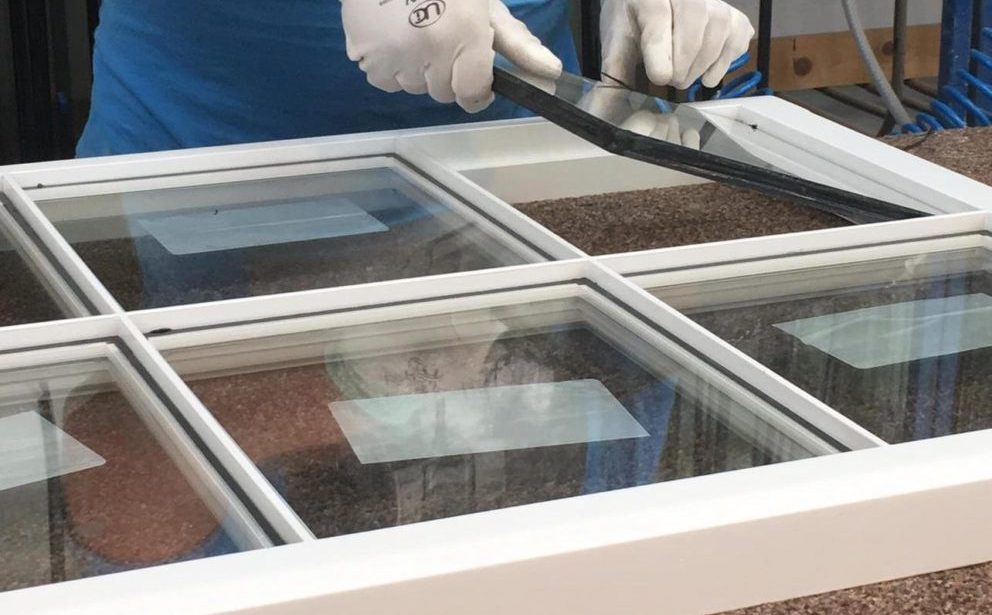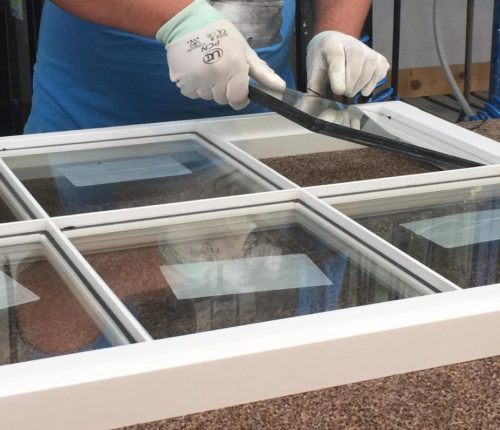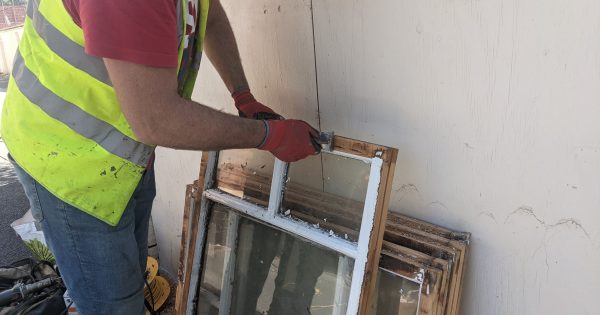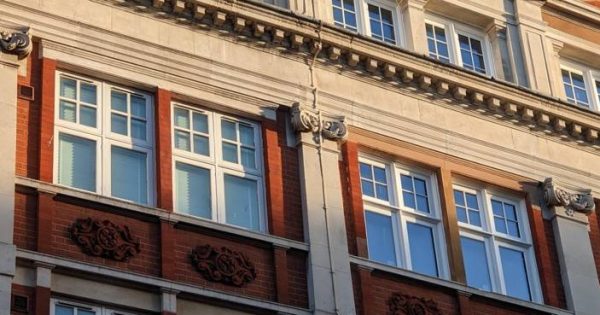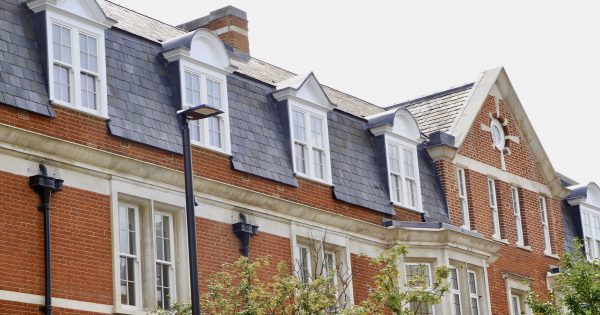Fri Sep 19
When you need to replace glass in window sash assemblies, technical precision and heritage sensitivity become paramount concerns. Whether dealing with broken glass panes in original sash windows or upgrading glazing for improved energy efficiency, the process demands careful planning and specialist expertise to ensure it is done right the first time.
TRC Contracts’ ultra-slim, sealed double-glazed units offer a 5-year guarantee and fit into most single-glazed openings, making glass replacement projects more achievable for heritage and high-performance applications. This blog outlines the essential considerations for architects, contractors and specifiers managing sash window glass replacement projects across the UK.
Understanding sash window glazing requirements
The technical demands of sash window glass replacement extend far beyond simply removing broken glass and installing new panes. Traditional sash windows were designed around specific glass weights, sightlines and structural tolerances that must be respected during any glazing upgrade or restoration work.
Modern replacement glass options include single glazing for heritage compliance, slimline double glazing for thermal performance, and specialist acoustic glazing for noise reduction, along with effective draught proofing solutions. Each option requires different technical approaches to installation, particularly when working within existing window frames that may have dimensional constraints or heritage protection requirements.
Working with listed buildings adds another layer of complexity. Planning authorities often require matching sightlines, putty bedding methods, and specific glass types that maintain the original architectural character. Understanding these requirements before beginning any glass replacement project prevents costly delays and ensures compliance with conservation regulations.
Glass types and their applications
Heritage and conservation glass
Original sash windows typically featured crown glass or early drawn glass with characteristic imperfections and optical qualities. When replacing glass in heritage projects, matching these visual characteristics becomes crucial for maintaining authenticity.
Modern heritage glass replicates the appearance of period glazing while offering improved durability and safety performance. This type of replacement glass works particularly well in conservation areas where visual continuity is essential, providing the authentic appearance of original glass panes without the structural vulnerabilities of antique glazing.
Laminated and safety glass
Where building regulations demand enhanced safety performance, laminated glass provides impact resistance without compromising sightlines. This becomes particularly relevant in commercial buildings, schools, and ground-floor applications where safety glazing requirements apply.
The installation of laminated glass in sash windows requires careful attention to weight distribution and sash balance. Additional glass weight may necessitate adjustments to sash cords, counterweights, and pulley systems to maintain smooth operation.
Vacuum glazing technology
Vacuum glazing represents the most advanced option for sash window glass replacement, offering exceptional thermal performance with an ultra-slim profile that maintains heritage sightlines. TRC’s vacuum glazed timber windows utilise two panes of glass separated by a vacuum, eliminating air and significantly reducing heat transfer.
This innovative technology achieves centre-pane U-values of 0.4W/m²K while maintaining the thin profile essential for listed buildings and conservation areas. The vacuum eliminates the ‘double image’ effect often seen in standard double glazing, making it ideal for heritage properties where visual clarity is paramount.
Vacuum glazing works by creating an insulating vacuum between two 4mm toughened glass panes, preventing heat loss or gain through the window. The units are fully recyclable and eliminate energy-intensive noble gases, offering both performance and sustainability benefits for heritage and high-performance buildings.
Acoustic and energy-efficient glazing
TRC’s replacement glass units feature two panes of 4mm glass filled with heavy gas for acoustic performance, with Low-E glass reflecting heat back into the room. These technical specifications demonstrate how modern glazing upgrades can address multiple performance requirements simultaneously.
Acoustic glazing typically requires asymmetric glass thicknesses and specialist interlayers to disrupt sound transmission. When specifying acoustic glass for sash window applications, consideration must be given to the increased weight and the potential need for upgraded sash hardware and counterbalancing systems.
Technical challenges in glass replacement
Managing sightlines and proportions
One of the most critical aspects of replacing glass in sash windows involves maintaining original sightlines and glazing bar proportions. Modern sealed units are typically thicker than single glazing, which can alter the window’s visual appearance and affect astragal bar relationships.
TRC always installs sealed units with 6mm beading to ensure good weather deflection and preserve the window’s life for many years. This technical approach balances performance requirements with visual integrity, ensuring that glazing upgrades don’t compromise the window’s architectural character.
Dealing with frame constraints
Existing sash window frames often present dimensional limitations that affect glazing options. Narrow rebates, worn putty grooves, and distorted frames can complicate glass replacement projects and require careful measurement and specification.
Before specifying replacement glazing, a detailed survey should identify any frame repairs or modifications needed to accommodate new glass. This might include rebuilding damaged rebates, adjusting sash dimensions, or upgrading weathering details to suit modern glazing systems.
Weight and balance considerations
Glass replacement in sash windows affects the overall weight balance of the window system. Upgrading from single to double glazing, or installing heavier glass types, may require corresponding adjustments to counterweights, sash cords, and pulley systems.
Professional sash window specialists calculate weight changes and adjust counterbalancing systems accordingly. This ensures smooth operation and prevents premature wear of moving parts, maintaining the window’s functionality for years to come.
Safety compliance and installation standards
Working with glass shards and broken panes
Safe removal of broken glass requires proper equipment, training, and waste disposal procedures. Glass shards or splinters pose significant safety risks, particularly when working at height or in confined spaces typical of sash window installations.
Professional glass replacement follows established safety protocols including personal protective equipment, secure work platforms, and controlled glass removal techniques. The use of a putty knife for proper disposal of old putty and contaminated putty ensures compliance with waste regulations and environmental standards.
Installation quality and weatherproofing
Modern glass replacement in sash windows demands high-quality installation techniques, including the application of silicone primer, that ensure long-term performance. This includes proper glazing compound application, weatherseal installation, and structural glazing methods that prevent water ingress and thermal bridging.
The use of elastic dry glazing sealant ensures durability, while warm edge spacer bars reduce perimeter condensation issues. These technical details contribute to the overall performance and longevity of glass replacement projects.
What are the most cost-effective approaches to sash window glass replacement?
The most cost-effective approach typically involves replacing only damaged panes while retaining good condition glazing and frames. Partial glass replacement reduces material costs and installation time while addressing immediate performance issues. However, comprehensive glazing upgrades may offer better long-term value through improved energy efficiency and reduced maintenance requirements.
Conservation requirements and listed building compliance
Planning permission and conservation area constraints
Glass replacement in listed buildings requires careful navigation of planning requirements and conservation officer expectations. Changes to glazing can affect a building’s historic character, making early consultation with planning authorities essential for project success.
Conservation areas often have specific requirements regarding glass types, installation methods, and visual impacts. Understanding these constraints before specifying replacement glazing prevents delays and ensures compliance with heritage protection regulations.
Matching historic sightlines and details
Successful glass replacement in heritage buildings requires meticulous attention to historic detailing. This includes matching glazing bar profiles, putty lines, and glass plane positions that maintain the window’s original architectural character.
Modern glazing upgrades must be carefully designed to work within heritage constraints while delivering improved performance. This often involves custom glazing solutions and specialist installation techniques that respect historic fabric while meeting contemporary requirements.
Managing client expectations and project delivery
Performance improvements vs heritage constraints
Clients often expect significant performance improvements from glass replacement projects, but heritage constraints can limit available options. Clear communication about achievable outcomes helps manage expectations and prevents disappointment with project results.
Providing detailed specifications, performance data, and visual examples helps clients understand the balance between heritage compliance and performance upgrades. This approach builds confidence and ensures project satisfaction.
Maintenance requirements and lifecycle costs
New glazing systems require ongoing maintenance to deliver optimal performance throughout their lifespan. Clients should understand cleaning requirements, seal replacement schedules, and potential repair needs for different glass types.
Quality glass replacement with proper maintenance can provide decades of reliable service, making it a worthwhile investment for heritage buildings. Regular inspections and preventive maintenance help identify issues early and prevent costly emergency repairs.
Key takeaways for professionals
When planning sash window glass replacement projects, consider these essential factors:
- Survey existing frames thoroughly to identify repair requirements and constraints
- Specify glazing types that balance performance requirements with heritage considerations
- Calculate weight changes and plan necessary adjustments to window hardware
- Ensure compliance with safety regulations and conservation requirements
- Provide clear information to clients about performance expectations and maintenance needs
- Work with experienced specialists who understand both technical and heritage requirements
Working with TRC Contracts for specialist glass replacement
TRC Contracts brings over 30 years of experience as sash window restoration specialists for historic buildings and new build projects, ensuring our work is completed to the highest standard. Our expertise in glazing upgrades, heritage compliance, and technical innovation ensures successful outcomes for complex glass replacement projects.
Whether you need emergency broken glass replacement, comprehensive glazing upgrades, or conservation-compliant solutions for listed buildings, our team provides the technical expertise and craftsmanship quality that architects and contractors depend on.
Contact TRC Contracts today to discuss your sash window glass replacement requirements and discover how our specialist services can deliver the performance, compliance, and peace of mind your project demands.

